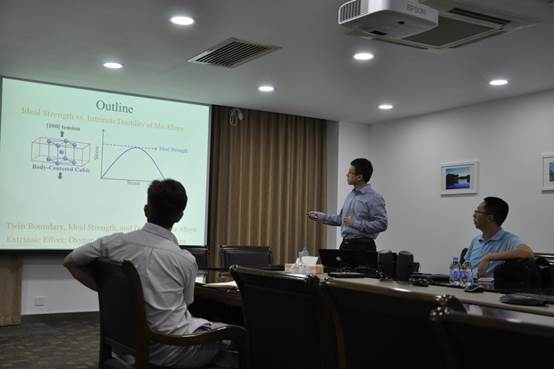|
NEWS
|
Location:Home>Seminars
First-Principles Studies of the Mechanical Properties of Transition Metal Alloys
Mr. Liang Qi, from University of Michigan, Ann Arbor, invited by Prof. Yongxing Shen, gave us a talk on July 21, 2016. Time & Date: 10:00 am, July 21 (Thursday), 2016 Location: Room 228, JI Building Title: First-Principles Studies of the Mechanical Properties of Transition Metal Alloys
Abstract
Predicting the mechanical strength and ductility of transition metal alloys remains challenging because these depend on a variety of intrinsic and extrinsic factors. In this talk I will discuss two recent examples to illustrate how first-principles calculations can be used to yield new insights into both types of factors, and provide strategies for alloy design. We will consider first the ideal tensile strength and corresponding intrinsic ductility for group 5 and 6 metal-based refractory alloys forming with body-centered cubic (bcc) structures. Group 6 metals, such as Mo and W, are intrinsically brittle, and this limits their applications. Our first-principles calculations show that alloying group 6 transition metals with group 4 or 5 transition metals can transform these materials into ones that display intrinsically ductile behavior. Remarkably, this transformation in ductility can be understood as an electron filling effect with the intrinsically ductile response the manifestation of a Jahn-Teller distortion. The second example will be devoted to hexagonal-close-packed (hcp) Ti, where it is known that very small concentrations of O interstitials can induce significant strengthening, but with the detrimental effect of lowering toughness. To provide new insights into this long-studied problem, we performed first-principles calculations to analyze the interactions between interstitial atoms and screw dislocation cores in hcp-Ti. Both indirect studies of generalized stacking fault energy and direct investigate of dislocation core show that oxygen and other large interstitials are strongly repelled by the screw dislocation core. This repulsion would forces these interstitials to “diffuse” from their original interstitial site during dislocation slip. The origin of this repulsion is the low symmetry structure of hcp lattice: in the hcp-Ti screw dislocation core, the interstitial volume is largely reduced. The results are shown to be in good agreement with experimental observations derived from in-situ small-scale mechanical tests.
Bio
Prof. Liang Qi received his PhD in 2009 from University of Pennsylvania under the guidance of Prof. Ju Li. After that, he had his postdoctoral research experiences in Prof. Ju Li’s group and then worked as an assistant project scientist under the supervise of Prof. Mark Asta, Prof. Daryl Chrzan and Prof. John W. Morris at UC Berkeley. Prof. Qi began his independent academic career from last year (2015) as an Assistant Professor of Materials Science and Engineering at University of Michigan, Ann Arbor. Prof. Qi has extensive experiences to investigate the materials chemical and mechanical properties based on first-principles calculations, atomistic simulations and multi-scale modeling. He also has extensive experience in collaborating with researchers in experimental fields. Prof. Qi worked on first-principles calculations and multiscale simulations of surface chemistry and electrocatalysis for oxygen reduction reaction in PEM fuel cell for his PhD thesis, where both the catalytic activity and stability of Pt and Pt alloys were his major research subjects. Starting from his postdoctoral experiences, he worked on simulations of nanomechanics in both structural and functional materials by collaborating with in-situ characterization experimentalists. He also worked on the theoretical investigations of thermodynamics and electronic properties of complex ionic compounds as nuclear waste storage materials. In recent years one of his major research areas are focused on the material mechanical and interfacial defect properties starting from atomistic scales. He recently studied the dislocation core structures in Ti and how the dislocations interact with impurities atoms. Currently he is working on the improvement of intrinsic ductility of transition metals by tuning the electronic structures and ideal strengths. He is also developing the methods to calculate the interfacial energies in alloys by applying statistical methods and first-principles calculations.
|



